La Salamandre – Bomb Ketch 1758

Description: Bomb ketchs were invented by the French in the 1660s in order to bombard port towns on the Barbary coast more efficiently. La Salamandre was armed with 8 guns of 6 pounds and the main armament consisted of two 12 inch mortars firing forward. For this reason, the rigging had to be changed – the foremast was removed and chain was used for the main stay. Firing the mortars required massive frames and beams than other ship type of this size.
This plank on frame scratch build will be done using the plans from another of Jean Boudriot’s monographs.
Started: September 2020
Scale: 1/48
Construction type: planks on frame
Project log
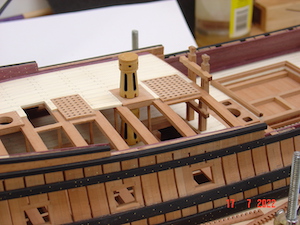
September 30, 2022
The ship interior arrangements are now completed. The hold, main deck, quarter deck and forecastle were only planked half their width. This together with the cut-outs on one side allow observing the interior.
Notable features: the main mast step aft the rider, the rack holding the 12 inch explosive bombs, the massive beams structure beneath the two mortars, the five layers of crisscrossed thick rope to absorb the mortar fire shock, the double bell capstan.
The build log was updated with more than 70 pictures.
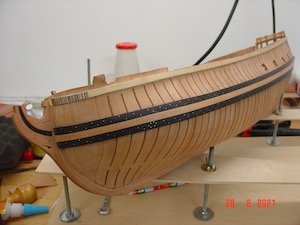
September 23, 2021
The frames were assembled in their final position on the keel with temporary spacers at the ends and with permanent ones above the keel and at the end of the floor timbers. The stern was also framed.
Next, the 8 gunports (4 on each side) were cut and framed. Also the two small windows (one on each side) at the stern.
Th inner planking was started at the keel with the unplanked space for the limber boards, then 6 more streaks of 6.5mm by 1.5mm planks were laid on each side – this cover the ceiling up to the end of floor timbers.
The wales were also installed. They are formed of two runs of 7mm by 3mm with a 7mm gap in between. They were made out of ebony cut to shape (as it is impossible to bend at this dimensions) and nailed to the frames with two 0.5mm brass wire nails at each frame.
Now the hull is strong enough to allow cutting a number fo frames on the starboard side (below the wale and above the end of floors) which will remain unplanked on the outside, to be able to see the interior arrangements, especially the reinforced structure for the two mortars.
The build log was updated with more than 50 pictures.
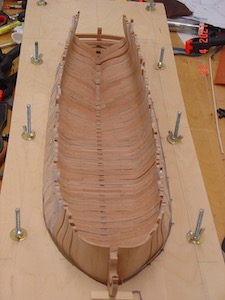
May 27, 2021
The keel, stern and stem posts were made and assambled. All 44 frames were done and are now installed on the keel.
The frames were built in French fashion as two slices of paired timbers overlapping the corresponding timber in the other slice by half their length so that their joints are staggered (shift of butts). First slice is composed of the floor, second and forth futtocks and long top timbers while the other is from a half-floor, first and third futtock and short top timbers.
These slices are hold together by 3 bolts at each overlap. I’ve used 0.5mm brass wire for this.
A build log was created and you can find it here.
Le Coureur – Lougre 1776 – Completed
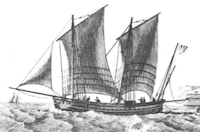
Description: The luggers were part of the French Royal Navy between 1773 and 1782 and were built by the engineer and builder Denys, in Dunkerque. The distinguishing feature of this type of ship were the lugsails: unlike the square sails, where the yard is attached to the mast at its middle, the lugsail yard is attached at one-third of its length. Another interesting thing about this type of ship was the clincker planking up to the main whale.
Once again, this scratch build will be done using the plans from another of Jean Boudriot’s monographs.
Started: April 2019
Finished: September 2020
Scale: 1/48
Construction type: planks on solid hull
Project log
September 12, 2020
The rigging and the sails are now done and with this the model is completed. The only thing left is to order the acrylic display case. Here is a short, 30 seconds video with a rapid overview of the finished model.
The build log was updated with the last pictures and a gallery for the finished model can be found here.
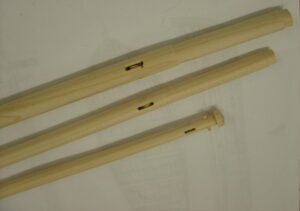
August 24, 2020
The masts were turned from yellow birch – five in total. They have a sheave with a brass turned wheel at the top. Once glued in place, the main and fore mast wedges were added.
The metal fittings were made from brass flat rod soldered and chemically blackened.
The yards were also turned from yellow birch but were painted black. They are asymmetrical the thickest part situated at 2/3 from one end and 1/3 from the other. Here they are octogonal in section for about 1/10 of their length and then they are round toward both ends.
The build log was updated with new pictures.
July 16, 2020
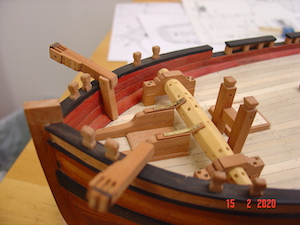
The deck furniture is now done: the hatches with their covers, the windlass, the two pumps, the rudder bar, the kitchen funnel, the anchors davits, the stands for the launch, the masts bits, the binnacle and the cabin skylight, the bowsprit partners, etc. The stern and stern decoration was also done.
The launch is built. As the lugger, the launch it is clinker built and big enough for six oarsmen sited on individual benches on the opposite side of where their corresponding oar is.
The 8 cannons were also built. They were bought as kits to be assembled from Syren Ship Model Company: box wood, laser cut carriages and turned brass barrels. After assembly the carriages were treated with tung oil and the barrels blackened with Jax.
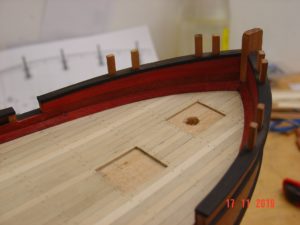
January 19, 2020
The deck, the upper part of the side planking and the bulwarks are now done. The deck was planked with holly wood. All planks were cut from a single piece of wood yet their color varies quite a lot. Most of the planks are curved slightly, their maximum width is 5mm and they are 1mm thick. The inside of the bulwarks and the waterways are made from blood wood. The moldings and the top of the bulwark are made from ebony as is the deck railing at the back.
The spaces corresponding to all deck openings and furniture were left unplanked. The deck planks were glued and nailed down with 0.3mm brass wire at each beam.
The build log was updated with new pictures – take a look!
September 22, 2019
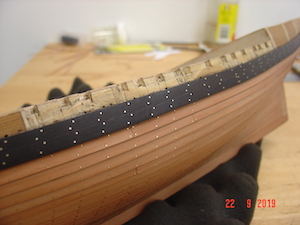
The clinker planking and the whale are now completed. There are 20 strakes of pear wood planks 1mm by 5mm overlapping about 1mm below the whale. The overlap reduces progressively toward bow and stern on the last 2 centimetres so they lay flat on the stern and stem posts.
The whale is made out of two strakes of ebony 2mm by 5mm carvel planked. Everything is “nailed” down with 0.5mm brass wire at every frame.
The side planking above the whale will be done only once the deck planking is laid down.
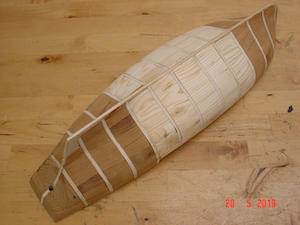
May 28, 2019
The solid hull is completed. Frames and keel were cut from 5mm plywood and the spaces between frames were filled with cedar and pine scrap wood. The deck was planked with 1mm by 25mm basswood strips. Once sanded the remaining gaps and irregularities were filled with wood filler.
Since I have enough material for a new build log, here it is.
La Jacinthe – Schooner 1825 – completed
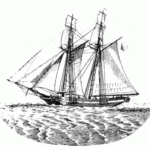
Description: Small, fast two masts, two guns vessel used by French Navy as dispatch-boat (aviso) her principal role was to deliver dispatches and to carry out reconnaissance and scouting duties. The rigging consists of two boom sails, three jibs on its bowsprit, cross-jack sails and flying topsails.
The build will be done using the plans from J. Boudriot’s monograph. I plan to fully rig the model and once done her size will be quite considerable 80cm x 25cm x 60cm (L x W x H).
Started: December 2017
Finished: March 2019
Scale: 1/48
Construction type: planks on solid hull
Project log
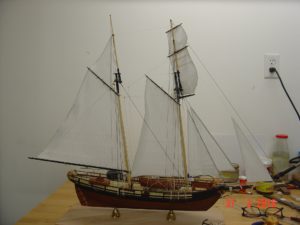
March 31, 2019
Rigging is now complete – all sails are done and set in place – the last one was the flying jib. The two previously made carronades were also glued in their final position.
The last thing done, was one of the two anchors – the bigger one – made from several pieces of brass sheet and copper rod, all soldered together and chemically blackened.
With this the model is now complete. The only things left to do, are the display base and case. I will do the base but the case will be ordered from a professional.
Last set of build log pictures were uploaded – check them out in the build log in the last gallery section (Masts & Rigging).
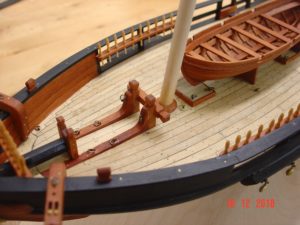
December 22, 2018
The deck is now complete: the two elm tree pumps, 44 pins in the pin-rails, the cutter attached on its stands, all the ringbolts in place, the two masts also set in their final position.
The two carronades are also made but only the base is set on deck with two steel pins – the rest of them will be glued on the base at a later time.
After all this was done, the deck and everything on it got several layers of tung oil. The rigging can now start.
Over 60 new progress pictures were uploaded – take a look!
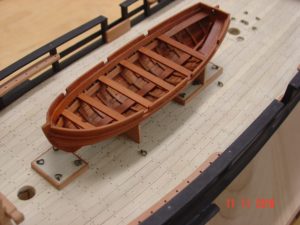
November 11, 2018
As the work advances slowly with the deck fitting, I undertook a small project: the 6 row cutter.
It is made from pear wood and was built using a plug made of MDF. The frames were steamed and bent over the plug, then their ends were glued to it. Once the keel and the upper most strake were glued in place the framing of the boat was removed from the plug and the rest of the planking was done. The finishing touch was done with tung oil.
This small project deserved its own build log.
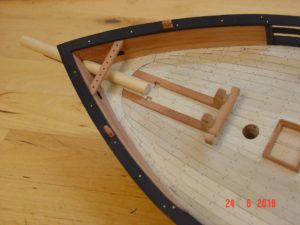
June 25, 2018
The deck is now finished. I used ebony for the bulwarks, except the inside of the fore part of the deck. I usually use carpenter glue for my models but for the ebony-on-ebony joints with such small contact surface I used CA glue. Plus I pinned everything with brass wire.
New progress pictures were uploaded in the build log.
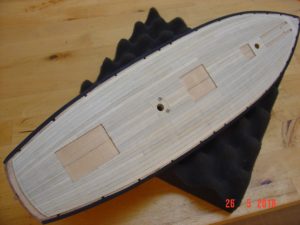
Mai 27, 2018
Finally after a very long wait (almost two months) I’ve received the 0.3mm brass wire from Thailand and I could finish the deck. The planks were cut from a single piece of holly but stil show a lot of colour variation – which I like. They are 1.5mm thick and I could not bend them sidewise, so I have to cut each one of them to shape.
The build log was updated with the new progress pictures.
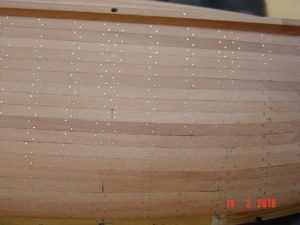
February 16, 2018
It took me about 20 hours over three weekends to “nail” the planking – to drill 0.5mm holes with my Dremel, glue in each a piece of brass wire with CA glue then file/sand the ends. There are a bit over 3000 of them (3038 to be precise) and I used about 11m (33ft) of brass wire.
I think by now I have enough material for a new build log so here it is.
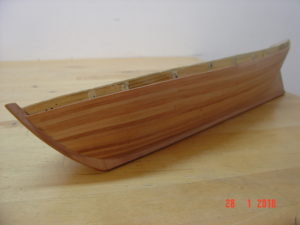
January 28, 2018
The hull planking, up to the whales is now completed. There are 18 strakes of pear wood 4mm by 2mm. They narrowed toward the bow and stern and there is one plank drop at the bow.
The whale will be done in two strakes of ebony but only after the deck is planked.
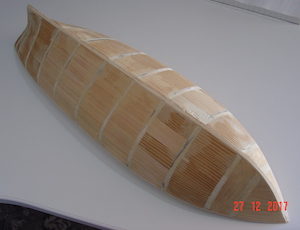
December 27, 2017
The solid hull is completed. Frames and keel were cut from 6mm plywood and the spaces between frames were filled with cedar wood. The deck was planked with 1.5mm by 25mm basswood strips. Once sanded the remaining gaps and irregularities were filled with wood filler. It does not look so good now, but all this will be covered with the final planking.